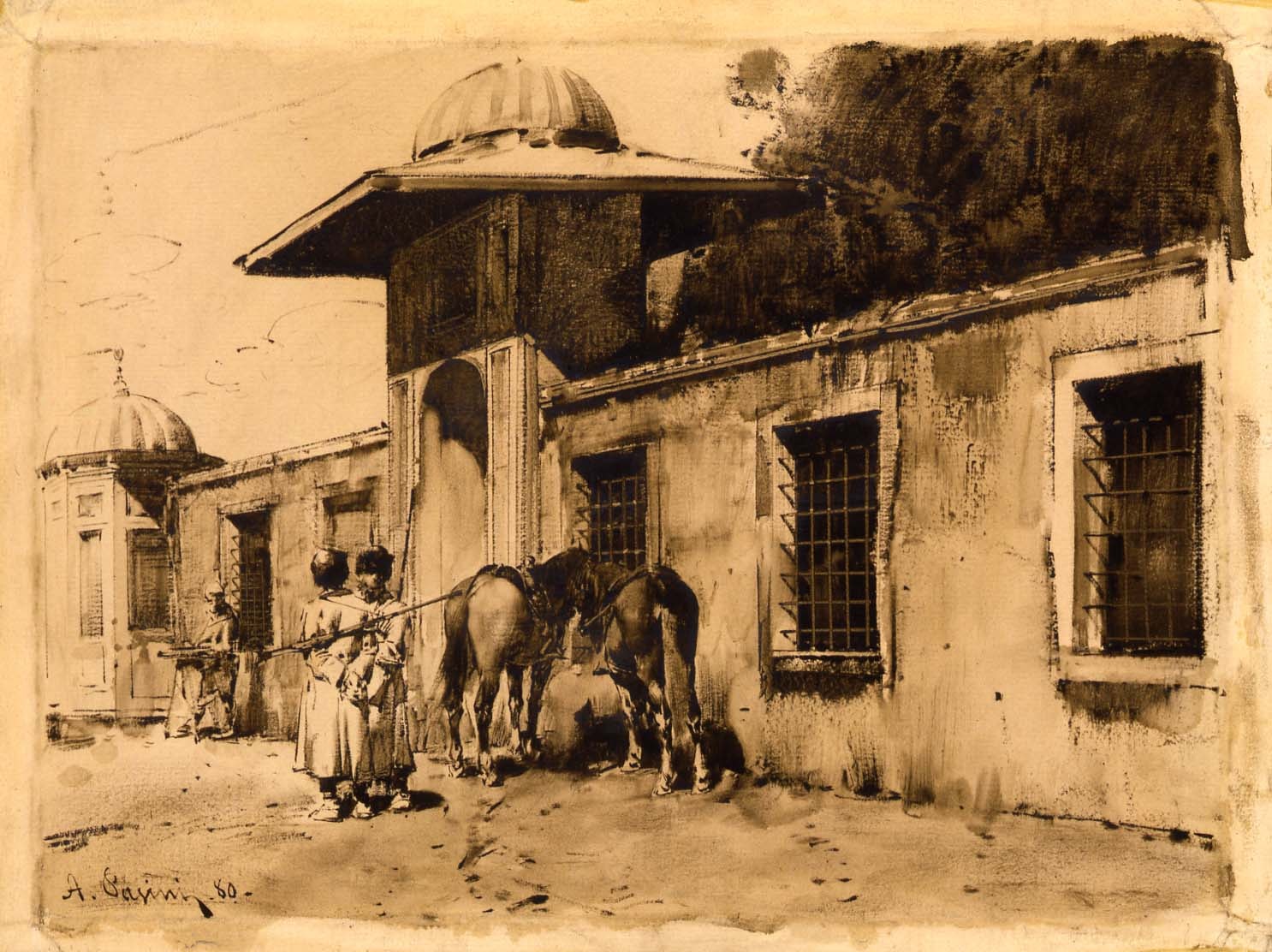Alberto PASINI
(Busseto 1826 - Cavoretto 1899)
Circassian Cavalrymen Outside a Gate
Sold
Pen and brown ink and brown wash.
Signed and dated A. Pasini .80. at the lower left.
264 x 349 mm. (10 3/8 x 13 3/4 in.) [sheet]
Signed and dated A. Pasini .80. at the lower left.
264 x 349 mm. (10 3/8 x 13 3/4 in.) [sheet]
This is a depiction of a type of subject that Alberto Pasini treated in paintings, drawings and lithographs throughout his career. (Indeed, in 1880 - the date of this drawing - he exhibited a large canvas entitled Cavaliers circassiens, attendant leur chef à la porte d’un monument byzantin at the Salon des Artistes Français in Paris.) Pasini’s interest in Circassian soldiers as subjects for his paintings is a reflection of a fascination for these singular people shared by many visitors to the Near East. The term ‘Circassian’, derived from the Turkish word ‘Çerkes’, has long been used to refer to the peoples of the Northwestern Caucasus, notably the Adyghe, the Abkhaz and the Ubykh. With the Tsarist Russian conquest of their territory in the first half of the 19th century, many Circassians were deported to Turkey, where Pasini would first have seen them.
A fierce people with a warlike ethic, greatly admired for their courage in battle, many Circassians became military leaders in Turkey, the Middle East and Russia after the diaspora. Circassian men wore a cherkessa; a long, fitted coat with pockets for ammunition cartridges across the chest, together with a round fur hat and knee-high leather boots. Their exotic appearance was described by one 19th century visitor to the region; ‘I was first struck with their fine martial appearance, athletic forms, regular features, and the proud consciousness of freedom displayed in every glance and movement. The most accomplished cavalier in Europe could not sit his horse with greater ease and grace than did these wild mountaineers; and the symmetry of the noble animals that carried them I have never seen equalled, except in our own country...The usual dress of a Circassian warrior of all classes is a tunic resembling a military Polonaise, without a collar, closely fitted to the body, and descending to the knee, secured around the middle by a leather girdle, ornamented, according to the wealth or fancy of the wearer, with gold or silver, in which are stuck a pair of pistols...In addition to this, the Circassian is armed with a light gun, slung across the shoulder, and a sabre suspended by a silk cord in the Turkish fashion...Hence, a Circassian, whether on foot, or on horseback, is at all times completely armed.’
A fierce people with a warlike ethic, greatly admired for their courage in battle, many Circassians became military leaders in Turkey, the Middle East and Russia after the diaspora. Circassian men wore a cherkessa; a long, fitted coat with pockets for ammunition cartridges across the chest, together with a round fur hat and knee-high leather boots. Their exotic appearance was described by one 19th century visitor to the region; ‘I was first struck with their fine martial appearance, athletic forms, regular features, and the proud consciousness of freedom displayed in every glance and movement. The most accomplished cavalier in Europe could not sit his horse with greater ease and grace than did these wild mountaineers; and the symmetry of the noble animals that carried them I have never seen equalled, except in our own country...The usual dress of a Circassian warrior of all classes is a tunic resembling a military Polonaise, without a collar, closely fitted to the body, and descending to the knee, secured around the middle by a leather girdle, ornamented, according to the wealth or fancy of the wearer, with gold or silver, in which are stuck a pair of pistols...In addition to this, the Circassian is armed with a light gun, slung across the shoulder, and a sabre suspended by a silk cord in the Turkish fashion...Hence, a Circassian, whether on foot, or on horseback, is at all times completely armed.’
Alberto Pasini received his artistic training at the Accademia di Belle Arti in Parma and began his career as a lithographer and landscape painter. He moved to Paris in 1851, entering the studio of Eugène Ciceri and exhibiting for the first time at the Salon of 1853. The following year Pasini transferred to the studio of Théodore Chassériau, who was responsible for introducing the young artist to the genre of Orientalism. In 1855 Pasini took the place (originally intended for Chassériau) of official artist to the delegation led by the French minister Prosper Bourée to Shah Nasi ad-din of Persia, with the aim of persuading the Shah to side with Britain and France against Russia in the Crimean War. The journey to Tehran, with the party travelling through Egypt and returning via Armenia and Turkey, resulted in numerous drawings and sketches by Pasini, as well as twelve lithographs published in Paris in 1859. Pasini returned to the Near East in 1860, visiting Cairo, the Sinai desert, Palestine, Lebanon and Athens. In 1867 he visited Constantinople at the invitation of Bourée, now the French ambassador to Turkey and a close friend and patron of the artist, and there received a commission from Sultan Abdul Aziz for four paintings for the palace at Dolmabahçe.
Pasini returned to Italy in 1870, settling at Cavoretto in the Piedmontese countryside near Turin. The 1870s and 1880s found the artist at the peak of his success as a painter. He continued to travel occasionally, visiting Turkey, Asia Minor and Syria in 1873 and twice travelling to Andalusia in Spain between 1879 and 1881, but for the most part his later travels took him to Venice. He exhibited eleven paintings at the Exposition Universelle in Paris in 1878, winning gold medals and earning nomination to the Legion of Honour.




